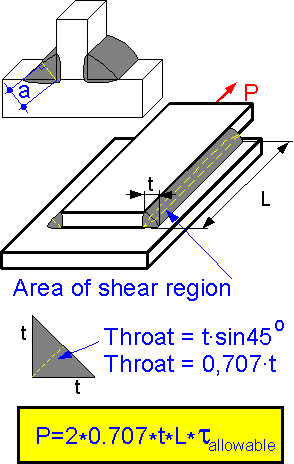 Strength of a welded joint depends on weld geometry and strength of materials. The minimum cross section of a weld is considered in strength calculations. Throat a is at a minimum. Throat is the distance from the root to the surface of a fillet weld. The throat of a fillet is a measure of the weld size. Critical force P for a lap joint using a 45 degree filet weld depends on allowable shear stress for the weld material tallowable.
Strength of a welded joint depends on weld geometry and strength of materials. The minimum cross section of a weld is considered in strength calculations. Throat a is at a minimum. Throat is the distance from the root to the surface of a fillet weld. The throat of a fillet is a measure of the weld size. Critical force P for a lap joint using a 45 degree filet weld depends on allowable shear stress for the weld material tallowable.
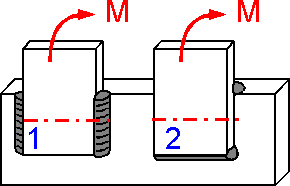 Bending stress is small if moment of inertia of the weld cross-section is large. The moment depends on the cross sectional area and it's distance from the neutral axis shown in the figure. The second example is three times stronger than the first.
Bending stress is small if moment of inertia of the weld cross-section is large. The moment depends on the cross sectional area and it's distance from the neutral axis shown in the figure. The second example is three times stronger than the first.
The tensile strength of a butt-joint is higher for the case with low stress concentration. Build-up welds are often produced to increase wear resistance, not tensile strength.
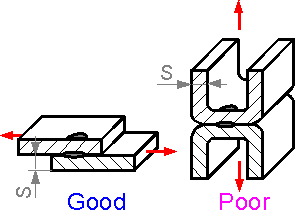 Spot resistance welding. The nugget is stronger under shear than in tension. Strength of nugget increases with thickness.
Spot resistance welding. The nugget is stronger under shear than in tension. Strength of nugget increases with thickness.
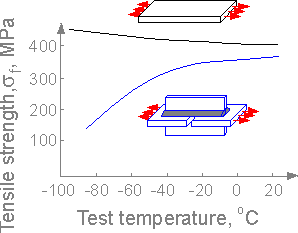 Contrary to uniform low-carbon steel plate, it's weld joint can have a brittle fracture mechanism: smaller critical stress at low temperature. Usually the temperature of brittle-ductile transition is below zero, ranging from -100oC to -40oC. Annealing increases the ductility of materials and prevents brittle fracture.
Contrary to uniform low-carbon steel plate, it's weld joint can have a brittle fracture mechanism: smaller critical stress at low temperature. Usually the temperature of brittle-ductile transition is below zero, ranging from -100oC to -40oC. Annealing increases the ductility of materials and prevents brittle fracture.
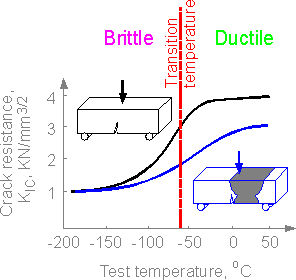 Crack resistance characteristic - the critical value of stress intensity factor depends on test temperature. Usually the brittle fracture for base metal, weld and heat-affected zone are similar, lower limits are equivalent. The characteristic of ductile fracture (upper limit) is usually smaller in the welded zone.
Crack resistance characteristic - the critical value of stress intensity factor depends on test temperature. Usually the brittle fracture for base metal, weld and heat-affected zone are similar, lower limits are equivalent. The characteristic of ductile fracture (upper limit) is usually smaller in the welded zone.
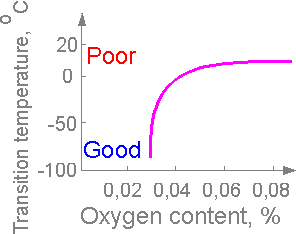 Presence of oxygen in weld material affects the embrittlement of the material. High oxygen content corresponds to embrittlement (relatively high transition temperature).
Presence of oxygen in weld material affects the embrittlement of the material. High oxygen content corresponds to embrittlement (relatively high transition temperature).
 2015-08-13
2015-08-13 426
426








